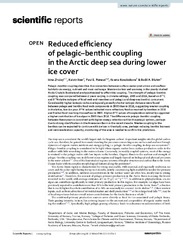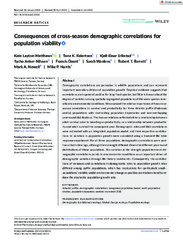Institutt for arktisk og marin biologi: Nye registreringer
Viser treff 341-360 av 2086
-
Reduced efficiency of pelagic–benthic coupling in the Arctic deep sea during lower ice cover
(Journal article; Tidsskriftartikkel; Peer reviewed, 2023-04-25)Pelagic–benthic coupling describes the connection between surface-water production and seafloor habitats via energy, nutrient and mass exchange. Massive ice loss and warming in the poorly studied Arctic Chukchi Borderland are hypothesized to affect this coupling. The strength of pelagic–benthic coupling was compared between 2 years varying in climate settings, 2005 and 2016, based on δ<sup>13</sup>C and ... -
Seasonal plankton dynamics in Kongsfjorden during two years of contrasting environmental conditions
(Journal article; Tidsskriftartikkel; Peer reviewed, 2023-02-24)Seasonal plankton time-series data are presented from Kongsfjorden from two years with contrasting environmental conditions. Kongsfjorden (west coast of Spitsbergen – 79°N) integrates inputs from Atlantic and Arctic waters, and glacier run-off, and is thus a prime location to study impacts on ecosystem dynamics of key environmental drivers that are relevant across the Arctic. Despite extensive ... -
Impact of Microsetella norvegica on carbon flux attenuation and as a secondary producer during the polar night in the subarctic Porsangerfjord
(Journal article; Tidsskriftartikkel; Peer reviewed, 2023-07-13)It is known that Microsetella norvegica feed on phytoplankton and provide an important link to higher trophic levels in Arctic fjords, such as fish sprat (Sprattus sprattus) and three-spined stickleback (Gasterosteus aculeatus). It has recently been suggested that M. norvegica may also contribute substantially to carbon flux attenuation during periods of high abundance. However, we still know very ... -
Under-ice observations by trawls and multi-frequency acoustics in the Central Arctic Ocean reveals abundance and composition of pelagic fauna
(Journal article; Tidsskriftartikkel; Peer reviewed, 2023-01-18)The rapid ongoing changes in the Central Arctic Ocean call for baseline information on the pelagic fauna. However, sampling for motile organisms which easily escape vertically towed nets is challenging. Here, we report the species composition and catch weight of pelagic fishes and larger zooplankton from 12 trawl hauls conducted in ice covered waters in the Central Arctic Ocean beyond the continental ... -
A Dynamic Occupancy Model for Interacting Species with Two Spatial Scales
(Journal article; Tidsskriftartikkel; Peer reviewed, 2023-04-10)Occupancy models have been extended to account for either multiple spatial scales or species interactions in a dynamic setting. However, as interacting species (e.g., predators and prey) often operate at different spatial scales, including nested spatial structure might be especially relevant to models of interacting species. Here we bridge these two model frameworks by developing a multi-scale, ... -
Photoperiod and dietary treatment in freshwater modulate the short-term intestinal response to seawater in Atlantic salmon (Salmo salar)
(Journal article; Tidsskriftartikkel; Peer reviewed, 2023-02-02)Stimulation and timing of smoltification are essential for successful Atlantic salmon (Salmo salar) aquaculture. This study investigated intestinal responses during dietary and photoperiod manipulation in freshwater (FW) and after a subsequent seven days residence in seawater (SW). “Small” and “large” Atlantic salmon parr (~40 g and ~ 130 g respectively) were treated in FW for 12 weeks and ... -
The Missing Link in the Genesis of the Lower Paleozoic Copper Deposits of the Anti-Atlas (Morocco): The Late Triassic Central Atlantic Magmatic Province Event
(Journal article; Tidsskriftartikkel; Peer reviewed, 2023-03-30)Copper mineralization in the Lower Paleozoic sedimentary cover of the Anti-Atlas (Morocco) is continually being revised not only to improve its mining capacity, but also to determine its origin, which remains a matter of debate. As evidenced by the various models proposed, the related research is fragmented, localized, and confusing. The origin of the Anti-Atlas Lower Paleozoic copper mineralization ... -
Sensitivity of bipartite network analyses to incomplete sampling and taxonomic uncertainty
(Journal article; Tidsskriftartikkel; Peer reviewed, 2023-01-23)Bipartite network analysis is a powerful tool to study the processes structuring interactions in ecological communities. In applying the method, it is assumed that the sampled interactions provide an accurate representation of the actual community. However, acquiring a representative sample may be difficult as not all species are equally abundant or easily identifiable. Two potential sampling ... -
Snowmelt contribution to Arctic first-year ice ridge mass balance and rapid consolidation during summer melt
(Journal article; Tidsskriftartikkel; Peer reviewed, 2023-05-29)An assessment of potential groundwater areas in the Ifni basin, located in the western AntiAtlas range of Morocco, was conducted based on a multicriteria analytical approach that integrated a set of geomorphological and hydroclimatic factors influencing the availability of this resource. This approach involved the use of geographic information systems (GIS) and hierarchical analytical process ... -
Delineation of Groundwater Potential Area using an AHP, Remote Sensing, and GIS Techniques in the Ifni Basin, Western Anti-Atlas, Morocco
(Journal article; Tidsskriftartikkel; Peer reviewed, 2023-04-06)An assessment of potential groundwater areas in the Ifni basin, located in the western AntiAtlas range of Morocco, was conducted based on a multicriteria analytical approach that integrated a set of geomorphological and hydroclimatic factors influencing the availability of this resource. This approach involved the use of geographic information systems (GIS) and hierarchical analytical process ... -
Behaviour and habitat use of first-time migrant Arctic charr: novel insights from a subarctic marine area
(Journal article; Tidsskriftartikkel; Peer reviewed, 2023-04-13)Anadromous Arctic charr Salvelinus alpinus is a cold-adapted salmonid that is vulnerable to climate warming and anthropogenic activities including salmon farming, hydropower regulation, and pollution, which poses a multiple-stressor scenario that influences or threatens populations. We studied the horizontal and vertical behaviour of Arctic charr tagged with acoustic transmitters (n = 45, mean ... -
Composition of Sugars, Organic Acids, Phenolic Compounds, and Volatile Organic Compounds in Lingonberries (Vaccinium vitis-idaea L.) at Five Ripening Stages
(Journal article; Tidsskriftartikkel; Peer reviewed, 2023-05-26)Wild lingonberries are a traditional source of food in the Nordic countries and an important contributor to economic activity of non-wood forest products in the region. Lingonberries are a rich source of bioactive compounds and can be a valuable contributor to a healthy diet. However, there are few studies available on how the bioactive compounds in lingonberries develop as they ripen. In this ... -
Maximizing sampling efficiency to detect differences in fish community composition using environmental DNA metabarcoding in subarctic fjords
(Journal article; Tidsskriftartikkel; Peer reviewed, 2023-04-14)Environmental DNA (eDNA) has gained popularity as a tool for ecosystem biomonitoring and biodiversity assessment. Although much progress has been made regarding laboratory and fieldwork protocols, the issue of sampling efficiency requires further investigation, particularly in three-dimensional marine systems. This study focuses on fish community composition in marine ecosystems and aims to analyze ... -
Structure and function of the western Baffin Bay coastal and shelf ecosystem
(Journal article; Tidsskriftartikkel; Peer reviewed, 2023-02-16)Arctic marine species, from benthos to fish and mammals, are essential for food security and sovereignty of Inuit people. Inuit food security is dependent on the availability, accessibility, quality, and sustainability of country food resources. However, climate change effects are threatening Inuit food systems through changes in abundance and nutritional quality of locally harvested species, ... -
Spatially and taxonomically explicit characterisation factors for greenhouse gas emission impacts on biodiversity
(Journal article; Tidsskriftartikkel; Peer reviewed, 2023-08-06)In life-cycle impact assessment, currently available characterisation factors (CF) for climate change impacts on biodiversity are highly simplified and do not consider spatial and taxonomic differentiation of species or local climate variability. We develop the first spatially and taxonomically specific CFs for the impacts of 20 GHGs on biodiversity considering 26,648 species across terrestrial and ... -
Revisiting the footprints of climate change in Arctic marine food webs: An assessment of knowledge gained since 2010
(Journal article; Tidsskriftartikkel; Peer reviewed, 2023-01-30)In 2011, a first comprehensive assessment of the footprints of climate change on Arctic marine ecosystems (such as altered distribution ranges, abundances, growth and body conditions, behaviours and phenologies, as well as community and regime shifts) was published. Here, we re-assess the climate-driven impacts reported since then, to elucidate to which extent and how observed ecological footprints ... -
Consequences of cross-season demographic correlations for population viability
(Journal article; Tidsskriftartikkel; Peer reviewed, 2023-07-12)Demographic correlations are pervasive in wildlife populations and can represent important secondary drivers of population growth. Empirical evidence suggests that correlations are in general positive for long-lived species, but little is known about the degree of variation among spatially segregated populations of the same species in relation to environmental conditions. We assessed the relative ... -
The role of water mass advection in staging of the Southern Ocean Salpa thompsoni populations
(Journal article; Tidsskriftartikkel; Peer reviewed, 2023-05-01)Salpa thompsoni is an important grazer in the Southern Ocean. Their abundance in the western Antarctic Peninsula is highly variable, varying by up to 5000-fold inter-annually. Here, we use a particle-tracking model to simulate the potential dispersal of salp populations from a source location in the Antarctic Circumpolar Current (ACC) to the Palmer Long Term Ecological Research (PAL LTER) study ... -
Tissue distribution of angiotensin-converting enzyme 2 (ACE2) receptor in wild animals with a focus on artiodactyls, mustelids and phocids
(Journal article; Tidsskriftartikkel; Peer reviewed, 2023-01-25)Natural cases of zooanthroponotic transmission of SARS-CoV-2 to animals have been reported during the COVID-19 pandemic, including to free-ranging white-tailed deer (<i>Odocoileus virginianus</i>) in North America and farmed American mink (<i>Neovison vison</i>) on multiple continents. To understand the potential for angiotensin-converting enzyme 2 (ACE2)-mediated viral tropism we characterised the ... -
Thermal acclimation of methanotrophs from the genus Methylobacter
(Journal article; Tidsskriftartikkel; Peer reviewed, 2023-01-18)Methanotrophs oxidize most of the methane (CH<sub>4</sub>) produced in natural and anthropogenic ecosystems. Often living close to soil surfaces, these microorganisms must frequently adjust to temperature change. While many environmental studies have addressed temperature effects on CH<sub>4</sub> oxidation and methanotrophic communities, there is little knowledge about the physiological adjustments ...


 English
English norsk
norsk


















